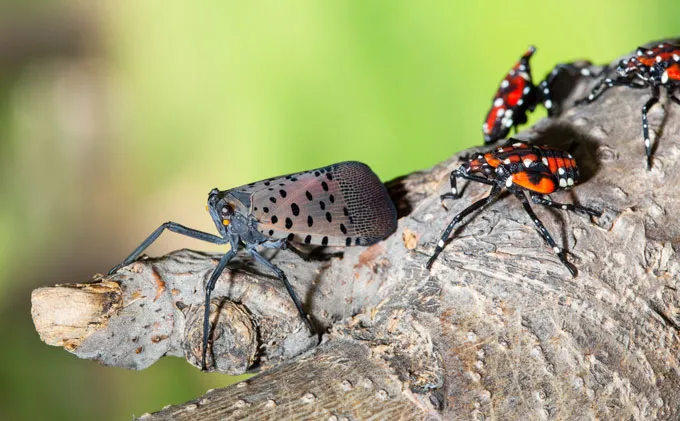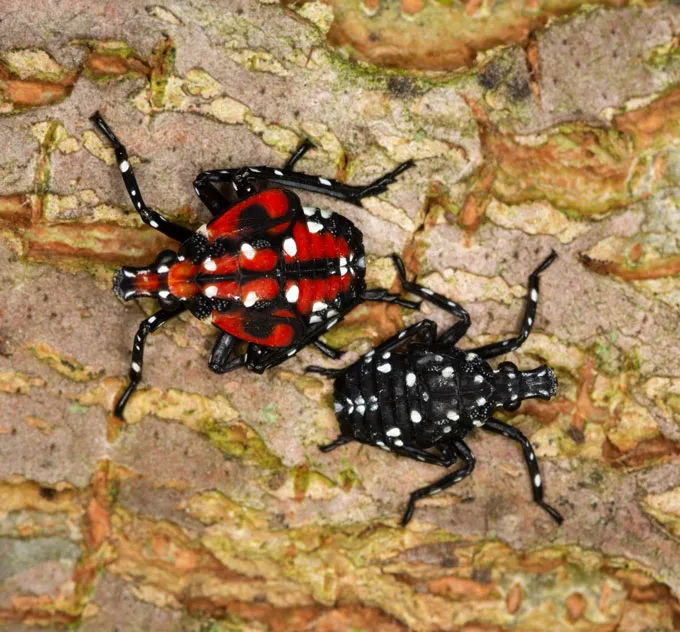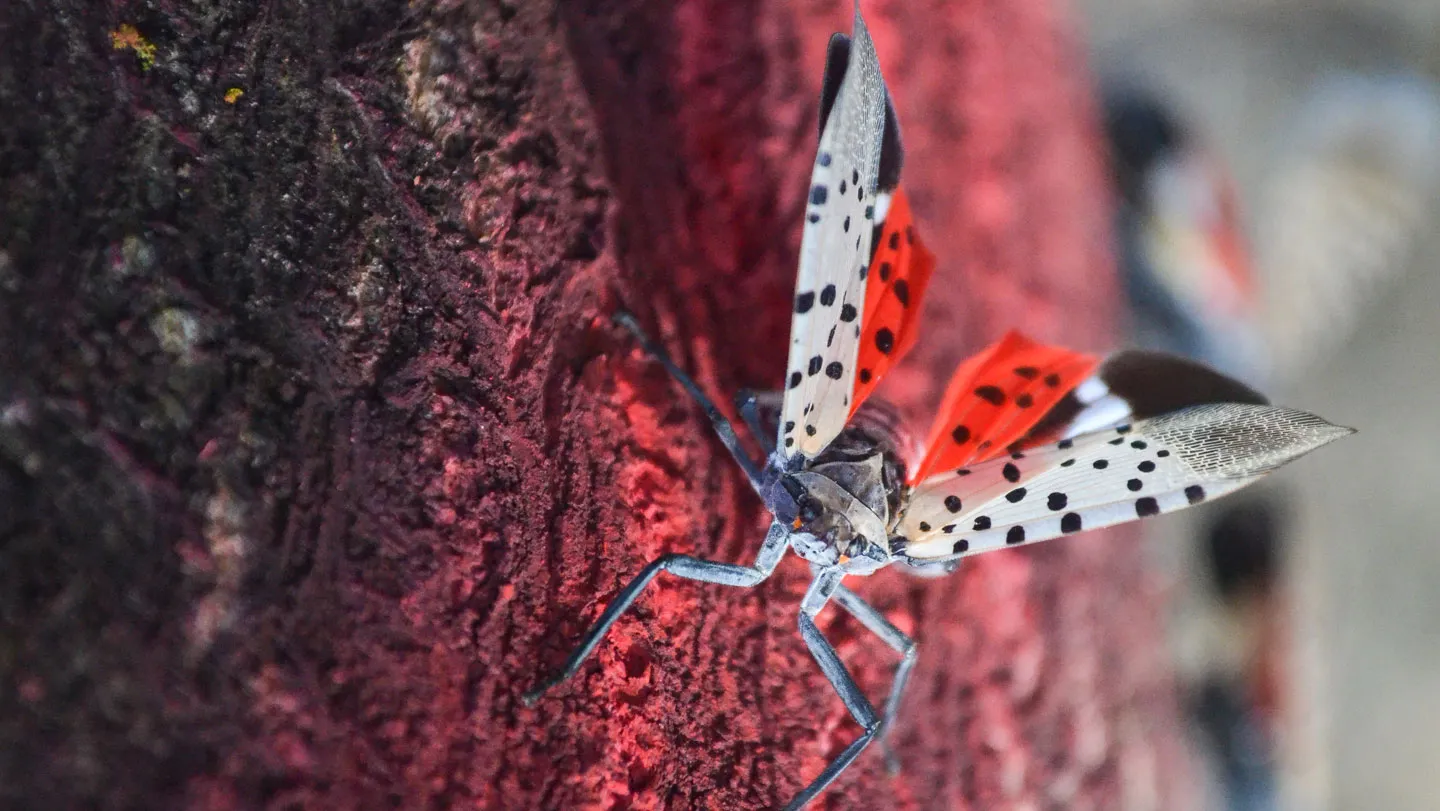A striking but destructive visitor is making its way across the United States. With their red-and-gray wings dotted like a fashion statement gone rogue, these insects drift along sidewalks, climb plants, and scale buildings. Younger ones bound away in sudden leaps, narrowly escaping the flattening force of a passing shoe.
Welcome to spotted lanternfly season.
Originally from China, India, and Vietnam, the spotted lanternfly (Lycoma delicatula) is an invasive plant hopper that has spent over a decade advancing through the Mid-Atlantic and Northeast. Studies warn that they could soon reach California. The invasion likely began in 2012, when egg masses arrived hidden on landscaping stone shipped to Berks County, Pennsylvania, though the pests weren’t officially spotted until 2014. Now present in at least 17 states, they have a broad menu of plants to feed on—particularly grapevines—sparking agricultural concerns over possible crop losses.

“When they first arrived in Pennsylvania, we didn’t know what to expect,” says Matthew Helmus, a quantitative ecologist at Temple University. “They were devouring all kinds of plants.” While the insects drain sap from many species without killing them, they show a strong preference for two: grapevines and the invasive tree of heaven (Ailanthus altissima), introduced to the U.S. from China in the late 1700s.
“If you enjoy wine, grape juice, or fresh grapes, that’s where the real impact could be,” Helmus warns. Heavy infestations can wipe out grapevines entirely, prompting high alert in grape-growing regions like California, Washington, and western Pennsylvania.
Urban residents have embraced lanternfly-stomping as a summertime pastime, and the bugs are vulnerable to certain pesticides. Yet, when sprays wear off, insects from nearby untreated plants quickly return.

“No one wants to flood the environment with chemicals,” says Flor Acevedo, an entomologist at Penn State. “They’re bad for the environment, bad for wildlife, and bad for people.”
Researchers are now exploring biological control methods—studying the lanternfly’s life cycle, natural predators, and diseases to find targeted solutions that protect vineyards without widespread chemical use.
The Tree of Heaven Connection
Lanternflies and the tree of heaven have a near-symbiotic relationship, and removing one could help limit the other.
Eggs laid in the fall hatch in late spring into tiny black nymphs speckled with white. Feeding on the sap of more than 70 plants, they grow into red-striped fourth-instar nymphs by midsummer. Adults emerge in late July, feeding heavily until fall, when they lay eggs before the first frost kills them.
“In just a few days, you can go from seeing one or two to being swarmed,” says Erin McHale, a biologist at Rutgers University.
Where they first appeared in Pennsylvania, tree of heaven was everywhere—thriving as a weed along roadsides, in fields, and in ditches—providing abundant food and helping the pests spread unnoticed. Lanternflies also feed on maple, birch, and black walnut. Experiments show that grapevines alone can sustain them, but survival and reproduction improve when tree of heaven is available. This suggests that removing these trees near vineyards might help—but they could also be used as pesticide-treated “trap trees” to lure and kill the pests.
Following the Spread
So far, major wine regions like California and Washington remain uninfested, but experts warn the species is edging toward the Lake Erie grape belt in Pennsylvania and New York. Without aggressive control, researchers estimate California could see lanternflies by 2033.
The insects don’t spread gradually—they make sudden “jumps,” often by hitchhiking on trains, vehicles, and shipping materials. States like New Jersey have imposed quarantines, requiring inspections before moving goods. Egg masses, which resemble gray smudges, are difficult to detect, making prevention tricky.

Dogs trained to sniff out eggs are proving effective, though there aren’t enough to meet demand. Volunteers with their own pets might one day be certified to assist in detection. Scientists are also testing environmental DNA sampling, ant droppings, and even computer vision to track populations before they explode.
Nature’s Allies
Some predators are starting to take notice. Birds, arthropods like spined soldier bugs, and even bats have been spotted feeding on lanternflies. In New Jersey, DNA from lanternflies was found in bat droppings, suggesting they could help control numbers.
In Asia, the parasitoid wasp Anastatus orientalis attacks lanternfly eggs, and while it’s unlikely to be introduced in the U.S., native species like A. reduvii—already known to target the eggs—show promise. Another candidate, Dryinus sinicus, lays eggs in lanternfly nymphs and is currently being tested by the USDA for safety.

Fungal pathogens are also emerging as potential bioinsecticides. In 2018, a mass die-off in Pennsylvania was linked to Batkoa major and Beauveria bassiana, both naturally occurring in U.S. soils. While B. bassiana is already sold for pest control and has shown strong results in field tests, B. major may be even deadlier—infected insects climb high, die in place, and release spores, spreading the fungus further.
Researchers hope these biological weapons could one day turn the tide—making the fight against the spotted lanternfly less about chemical warfare and more about restoring balance in the ecosystem.
